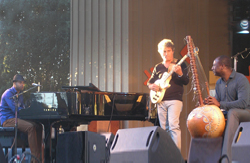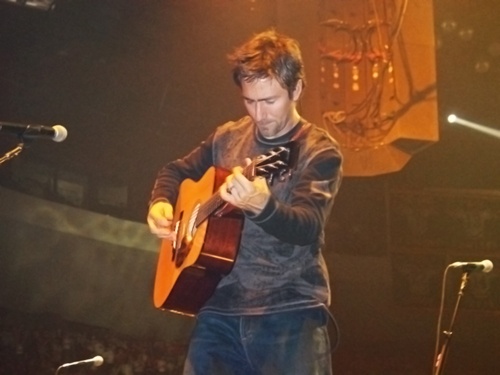
A recent solution is the L.R. Baggs Lyric system. Designed to be mounted in the guitar, the system includes a full-range directional mic in a specially designed noise-cancelling mounting that attaches inside the instrument on the guitar’s bridge plate, a small rotary volume control and presence setting on the underside of the sound hole, and an end-pin jack containing sophisticated tonal circuitry – including compression, limiting, and EQ to output a balanced acoustic sound.
The system allows freedom of movement for the performer, since the mic always stays in the same position. I tested the Lyric by installing it into a custom handmade acoustic by luthier Mike Kelly (of Goodyears Bar, CA), with good results.
Keith Sewell, a touring guitarist with Lyle Lovett and the Dixie Chicks (among others), has been involved with the system since it was in prototype in 2012, seeking an internal mic-only solution for performing in amphitheatres and other large venues that would sound as close as possible to an unamplified acoustic.
Because every venue and stage differs, Sewell says the Lyric needs a bit of tweaking each night, but once dialed in, he states, “it’s the best sound I’ve ever had as far as a guitar pickup,” adding that there is no way he could get even the best condenser mic as clear and loud in a live setting.
Lovett’s FOH engineer, John Richards, finds the mic very stable and musical in the mix. In a full band setting, he uses a high-pass filter at around 100 Hz on the guitar.
Other effective solutions I’ve run across include an AMT S15G mic, which has a gooseneck external cardioid condenser element that positions between 3 to almost 6 inches above the surface of the guitar using a specialized clamp for the body and a beltpack preamp.
The DPA d:vote 4099G acoustic guitar mic provides a supercardioid element on a gooseneck with body clip, and is used externally pointing toward guitar. DPA offers a variety of exchangeable clips for this mic so that it can be used on violins and other strings, brass instruments, piano, drums, and so on.
And, the Fishman Ellipse Matrix Blend combines an under-saddle pickup with a miniature cardioid gooseneck condenser mic that goes inside the instrument.
Guitar Amp
With decades of touring and studio experience, Mick Conley has miked his fair share of guitar amps. His choice is often a Shure SM7, more typically used in radio broadcast as an announce mic. Though by the specs the SM7 is cardioid, Conley cites its “really tight pattern that isolates so well” as a key reason it works as desired in this application. It also includes bass roll-off and midrange presence boost controls for further tonal shaping.
When he has the time at a given show, he moves the mic position a bit to find the “sweet spot,” listening through the house system. When using the same guitar amps at every stop on a tour, he may also mark the best spot with a piece of tape.
Dube has a few favored mics for guitar amps, including the ubiquitous Shure SM57. He also sometimes selects a ribbon mic such as a figure-8 Royer R-121 or a beyerdynamic M160 hypercardioid – or if available, a Sennheiser MD409 dynamic supercardioid (currently updated to the e609 Silver).
He emphasizes that mic positioning is critical to maintain a correct phase relationship, adding “use your ears.” Depending on the guitar, playing style, and amp, finding the best place to point the mic between the edge and center of the speaker cone is also a matter of listening.
Kick Drum
Also while at Monterey, I ran into FOH engineer Dunning Butler as he was returning from the on-site equipment area with a mic to solve an audio problem on an upcoming performance at a venue that’s dubbed “Dizzy’s Den” at the festival.
It’s a long, rectangular room, designed for county fair displays rather than musical performances. As an acoustic space, it could be accurately described as “tubby” since its dimensions tend to accentuate low-frequency energy coming from the stage and the loudspeakers – leading to a lack of definition for bass instruments and kick drum.

